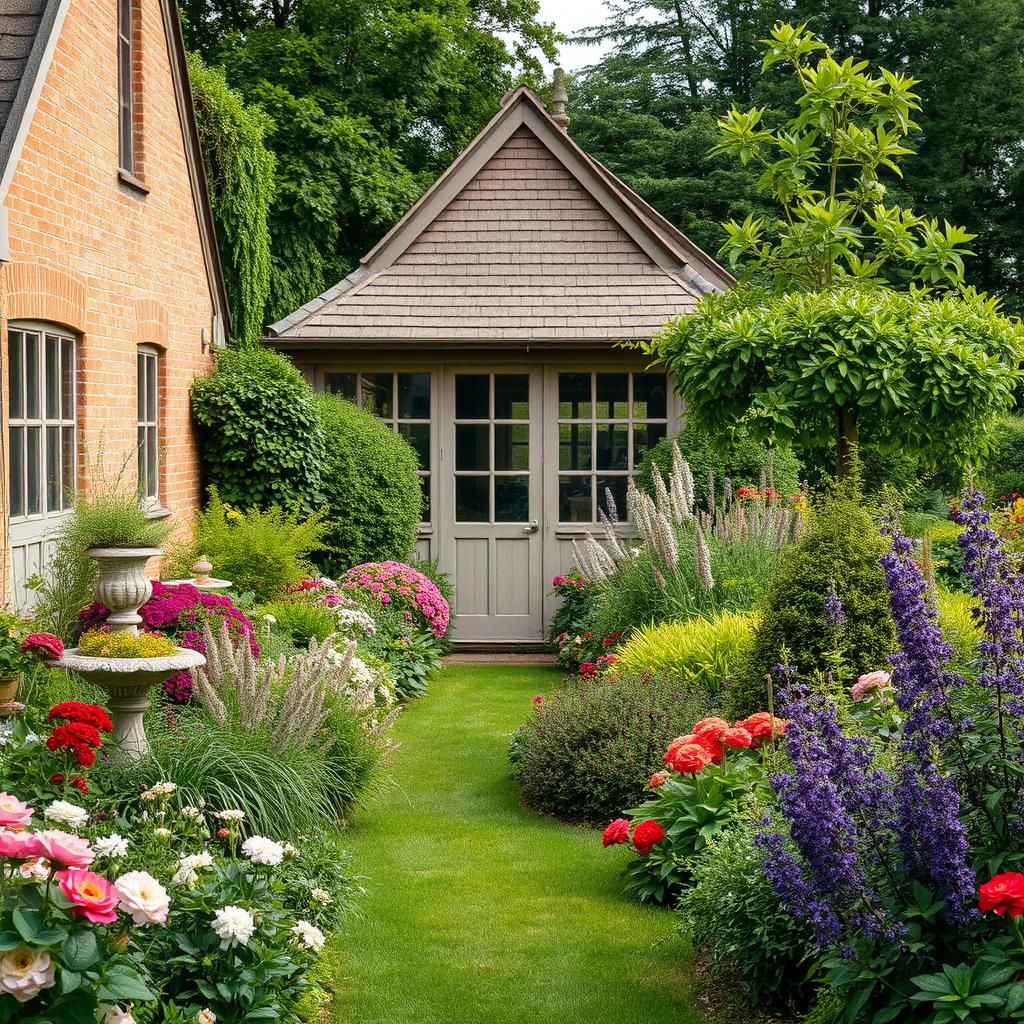What's the Difference Between an English Garden and a French Garden? Unveiling the Unique Features and Styles

When it comes to garden design, English and French gardens offer distinct approaches that reflect their cultural roots and aesthetic values. While both styles emphasize beauty and harmony with nature, they each boast unique features and layouts that set them apart. English gardens are often characterized by their informal, romantic charm, showcasing a variety of plants in a naturalistic manner. In contrast, French gardens are known for their formal structure, meticulous symmetry, and grandeur. This article will explore these two renowned gardening styles, unveiling the elements that define them and the qualities that make each one a unique expression of artistry.
Differences Between English Gardens and French Gardens
The primary difference between an English garden and a French garden lies in their design philosophies and aesthetic approaches. English gardens, often referred to as landscape gardens, emphasize a more natural and informal look, featuring winding paths, mixed plantings, and an abundance of flowering plants alongside trees and shrubs. Their aim is to create a harmonious blend with the natural surroundings. In contrast, French gardens are characterized by their formal, geometric layouts, symmetry, and meticulous organization, typically featuring straight paths, perfectly trimmed hedges, and carefully placed statues or fountains. They are often designed to convey a sense of order and elegance, mirroring the art and architecture of the French Renaissance.
Design Philosophy
The design of an English garden promotes a sense of naturalism, often incorporating elements that mimic the wilderness, while a French garden focuses on order and symmetry, reflecting classical aesthetics through structured planting and geometric patterns. This divergence in philosophy leads to distinct experiences where English gardens invite exploration and surprise, whereas French gardens provide a sense of grandeur and formality.
Plant Selection
In English gardens, plant selection tends to be diverse, with a love for perennials, wildflowers, and a variety of colors and textures that change with the seasons. This diversity encourages biodiversity and mimics the unpredictable nature of wild landscapes. On the other hand, French gardens typically feature topiary and neatly organized flower beds, predominantly showcasing annuals and other plants arranged in harmonious colors that align with the garden's structured design.
Layout and Structure
The layout of an English garden is often asymmetrical, with meandering paths that encourage wandering through various garden rooms filled with textural contrasts. In contrast, a French garden boasts a formal layout with straight lines and symmetrical axes leading to a focal point, such as a statue or water feature, demonstrating a masterful design aimed at mirroring the beauty of man-made structures.
See also:
Water Features
Water features in English gardens are typically more organic and may include ponds, streams, or rustic fountains integrated into the landscape, promoting a sense of tranquility. Conversely, French gardens often utilize grand fountains and reflective pools designed symmetrically, serving as essential focal points that enhance the overall grandeur and opulence of the garden.
Maintenance and Care
The maintenance of an English garden can be labor-intensive, as the informal style encourages a more natural growth of plants, requiring periodic intervention to maintain balance and diversity. In contrast, a French garden demands meticulous upkeep to preserve its formal appearance, with significant attention paid to pruning, edging, and positioning of plants to maintain symmetry and order throughout the year.
| Aspect | English Garden | French Garden |
|---|---|---|
| Design Philosophy | Naturalism | Order and Symmetry |
| Plant Selection | Diverse Perennials | Topiary and Harmonious Colors |
| Layout | Asymmetrical Paths | Formal Symmetrical Design |
| Water Features | Organic Ponds | Grand Fountains |
| Maintenance | Labor-Intensive | Meticulous Upkeep |
Exploring the Historical Context of English and French Gardens
The historical context of English and French gardens plays a vital role in understanding their distinct characteristics. English gardens, often characterized by their naturalistic style, evolved during the 18th century's Romantic period, where the emphasis was on creating an idyllic landscape that appeared almost untouched by humans. In contrast, French gardens, particularly during the Baroque era, reflect a more formal and structured design, heavily influenced by the rigorous geometries of royal ambitions, exemplified in places like the Palace of Versailles. This divergence is profoundly rooted in the different cultural values and environmental approaches of both nations, with English gardens favoring wildness and softness, while French gardens cultivated a sense of control and order.
Key Elements of English Garden Design
Key elements of English garden design include a focus on informality and a deep connection with nature. These gardens often feature a variety of curved pathways, wildflower borders, and mixed plantings, which create a sense of serendipity. Unlike their French counterparts, English gardens prioritize the concept of the "natural" look, allowing plants to grow in a more untamed manner, often incorporating elements like meandering streams and woodland areas to enhance the pastoral feel.
The Formality of French Garden Layouts
The formality of French garden layouts is epitomized by their geometric precision and carefully planned symmetry. Gardens are often designed with long axial paths, manicured hedges, and focal points such as statues or fountains, emphasizing the garden as a human-made paradise. This structured approach not only reflects the power and wealth of the patrons but also serves as a visual representation of order and control over nature, making it distinctly different from the free-flowing English style.
See also:
Cultural Influences on Garden Development
Cultural influences have profoundly shaped the development of both English and French gardens. The English garden was heavily influenced by the Romantic movement, which celebrated individualism and the beauty of nature, resulting in gardens designed to evoke emotion and contemplation. Conversely, in France, the garden was seen as a reflection of royal power, designed to impress and enthrall visitors, demonstrating not just aesthetic but also political agendas through their grandeur and meticulous cultivation.
Plant Choices and Their Symbolism
The plant choices in English and French gardens also highlight significant differences in their design philosophies. English gardens often feature a rich tapestry of native and exotic species, allowing for a more relaxed atmosphere where plants intermingle freely. In contrast, French gardens typically showcase a more limited selection of specified plants arranged for maximum visual impact and symbolism, often integrating herbs and flowers that reflect royalty and status, such as roses, which symbolize beauty and fragility.
Maintenance Practices Unique to Each Style
Maintenance practices play a crucial role in how both types of gardens are perceived and enjoyed. English gardens require a more hands-off maintenance approach, promoting a sense of natural growth and allowing for the occasional wildflower to thrive. This contrasts with French gardens, which demand meticulous upkeep and careful pruning of plants to maintain their precise shapes and design integrity, creating a stunning yet labor-intensive display that requires constant vigilance to achieve the desired aesthetics.
Questions from Our Readers
What are the main characteristics of an English garden?
An English garden is often characterized by its naturalistic style, featuring curved paths, informal flower beds, and a wide variety of plants. These gardens aim to mimic nature, creating a sense of serenity and harmony through the careful arrangement of flowers, shrubs, and trees that often encourage a wildflower look.
How does a French garden differ in design from an English garden?
A French garden typically embraces a more formal and structured design, showcasing symmetry, geometric shapes, and well-defined paths. Unlike the informal approach of English gardens, French gardens are often adorned with topiaries, fountains, and neatly trimmed hedges, emphasizing an orderly and aesthetic pleasing appearance.
See also:
What types of plants are commonly found in English gardens?
Common plants in English gardens include roses, lavender, and a variety of perennials that thrive in a more natural setting. These gardens often feature a mix of herbaceous plants and climbers, promoting a lush, colorful landscape that evolves with the seasons and attracts wildlife.
Are there any historical influences on the development of English and French gardens?
Yes, historical influences play a significant role in the development of both garden styles. English gardens were shaped by movements such as Romanticism, which favored natural beauty, while French gardens were influenced by the Baroque period, focusing on grandiosity and control over nature. This reflects their cultural values and ideals in garden design throughout history.

If you want to read more articles like What's the Difference Between an English Garden and a French Garden? Unveiling the Unique Features and Styles, we recommend you check out our Landscaping category.
Leave a Reply
Related Articles